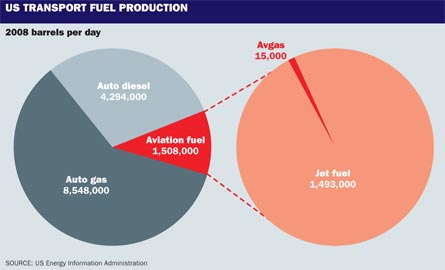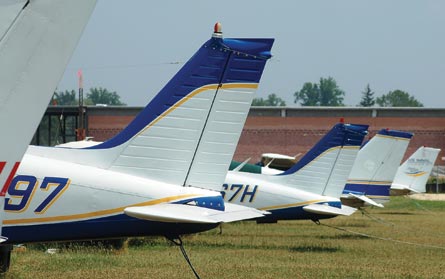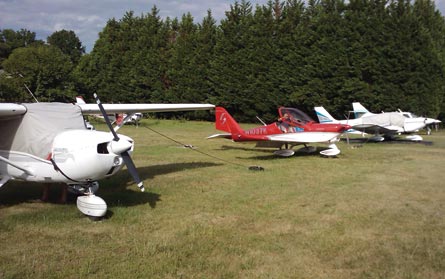Everything that is good and bad about the state of general aviation in the USA going into this year's AirVenture show is on display at one small privately owned public airport in suburban Maryland.
Although it is nestled in a relatively high-density, high-tech, white collar area close to the US Naval Academy in Annapolis and 40km (25 miles) east of the nation's capital, Lee airport, with its single 760m (2,500ft)-long, 14m-wide paved north-west by south-east runway and fuel-pumping mechanical maintenance shop, finds itself in an economic and social quandary.
|
|---|
A US Navy-funded programme to screen potential naval aviators and naval flight officers unexpectedly fizzled out in May, leaving the airport's only civilian flight training operation, the Navy Annapolis Flight Center (NAFC), largely without a raison d'être. Although a handful of civilian pilots continue to train and rent the Part 141 centre's 13 aircraft, three of which are now covered up and parked for lack of use, the lost revenue stream, possibly as much as $1 million a year from the 200 or so cadets that had previously cycled through, has left a hole in the fuel and maintenance sales for Chesapeake Aviation, the airport's only fixed-base operator.
Chesapeake says it will lose 40% of its revenue, on top of 20% it had already lost when the government after 9/11 created special flight security rules in the region that require pilots to file mandatory flight plans, obtain transponder codes and talk to controllers when departing the pattern. Pilots will often not fly due to the added hassle. "It's not going to be a good year," says Larry Donaldson, manager of the company.

The ripple-down effect of that loss of revenue and people traffic will also affect local restaurants and stores. The flight centre's 12 full-time flight instructors have been cut to seven. Many of those are working second jobs. One instructor now walks dogs as a sideline.
The meltdown exposes the fragile nature of many general aviation airports in the USA, the primary interfaces between pilots and piston-powered aircraft, both of which are decreasing in alarming numbers. According to the General Aviation Manufacturer's Association (GAMA), the private pilot population has been decreasing at an average rate of 10,000 pilots a year, down to about 200,000 in 2009 compared with 300,000 in 1990. It is no secret the aircraft makers are also under stress, with the total number of certificated piston aircraft shipments falling to 965 last year from levels nearly three times that high just two years before. Pilots themselves are flying less due to the economy. Chesapeake Aviation's Donaldson says the 80 aircraft that call Lee home fly on average about 9-12h a year, down from 20-30 before the economy tanked in 2008.
NO SERVICES
If Chesapeake Aviation cannot remain viable, the 80 or so tenants keeping their aircraft parked at a field with no fuel or maintenance services are likely to move on or give up flying. At full swing, the NAFC was spending $20,000 a month in fuel, a number that has dropped by 75%, says the flight centre's chief pilot, Frank Kennedy. US Federal Aviation Administration records show the facility was generating 22,000 take-offs and landings a year from tenants, an average of 60 a day in 2009.
With much less revenue to pay its property tax bill, the airport owner would be hard pressed not to think about selling the plot to developers hungry for the prospect of large-lot houses on the doorstep to Maryland's capital city, an area that would seem fertile ground for nurturing all manner of GA pilots for both pleasure and business. Given the financial turbulence that has trickled down to the state and local level, municipalities are not in a position to purchase or run an airport, and some of them have been looking to divest their airports, says the Aircraft Owners and Pilots Association (AOPA).
|
|---|
"The flight school, the mechanic and myself are all intertwined in this," says Van Lee, airport manager and son of the long-time owners of the airport. Lee says the airport, which is still owned by the family seven decades after its creation, gets a small percentage of the fuel sales to help with costs.
"If the airport pays for itself, the family is happy," says Lee. It is the "paying for itself" part that is in question now.
That is the bad part. The good part is beginning to emerge from the response of the local pilot community to a call for help from the airport manager, a response that shows the same resilience the GA brotherhood and sisterhood has shown in the face of every disaster and hardship thrown its way. It is an attitude and outlook on display every year at the Experimental Aircraft Association's AirVenture event, more like a phenomenon, that takes place in Oshkosh, Wisconsin in mid-summer every year. The show is now in its 57th year.
Front and centre in the Lee debate is how does an airport and an airport community transform itself from the "old" days of aviation to the new, which includes gaining the support of surrounding communities that often want the facility closed because of noise or perceived or real safety concerns.
"We have to figure out what we want to be," says John Sullivan, a retired Arinc vice-president and former US Air Force fighter pilot and test pilot who has taught part-time as an NAFC instructor for more than two decades. In the late 1970s and 1980s, Sullivan and other volunteer pilots would bring midshipmen to a nearby airport to give them flight instruction for free. The official training contract at Annapolis would come much later, in 2002.
In those days, civilians anxious to learn to fly would seek out the airport and fly in practically any aircraft offered with little to no creature comforts in the airport or FBO facility itself. Although safe, the 1970s-era Cessna and Piper single-engined aircraft are dated, with old style steam gauge instruments, many times augmented with a yoke-mounted portable GPS unit, but not always.
Although worn, the aircraft are generally cheaper in which to train compared with a new, modern aircraft with glass cockpits, autopilots and integrated GPS navigation. Along with the aircraft, an old-style airport is quickly identified by its worn but homey buildings, with restrooms that do not generally make a pleasant first impression on non-enthusiasts. Lee airport is no different.
Suggestions from the pilot community to boost civilian pilot operations and public support include bringing new light sport aircraft on to the flightline; installing a viewing area at a new Giant food store being built adjacent to the field, complete with history of the airport and contributions to the community; developing an airport website that "informs and entertains"; getting volunteer duty pilots to direct aircraft to parking, meet and greet transients and keep the bathroom clean; opening an avionics repair facility; sprucing up the buildings with new paint and landscaping, getting a restaurant on the field; creating an airport board, even having an "Old Timers Day" where former military pilots could entertain the local pilots and community with real-life high adventure stories.
AOPA offers a variety of suggestions for precisely these kinds of situations, including forming a pilots' association to galvanise and optimise the preservation effort; considering a public or private buy-out of the airport, and reaching out to the community to publicise the benefits of having the airport, not the least of which its "green-space" value in an otherwise developing suburban region.
Getting more people to fly is a different challenge. While enthusiasts are still around in small numbers, the new student is more likely to be more technically savvy, given cell phone and gaming technology advances. Along with glass cockpit cockpits now available in GA aircraft from virtually all manufacturers, flight schools are also beginning to buy sexy-looking lower-cost, factory-built LSAs that pilots can use to train for traditional pilot licences or for sport pilot licences, which are more limited but can be attained in half the hours, in theory.
Now five years old, the category had produced 3,375 pilots by the end of 2009, says the FAA, a plus, but not a saving grace for the declining pilot population by any means.
"Getting new pilots is an issue that occupies a lot of people's time," says Pete Bunce, president of GAMA. Bunce says one promising option is to bring in the growing number of military pilots being trained to fly remotely piloted vehicles. "The air force and other services are pumping out a lot of these men and women that are going to get almost enough flight training to get a ticket," he says. "I think we have to market to a new population in a different way than we have in the past. We've got to reach out to people with very internet savvy techniques to be able to capture them globally."
AOPA is working a new angle with a decidedly different tack - getting the ones who dropped to come back. "A lot of people have an interest in flying," says Melissa Rudinger, who is senior vice-president of government affairs at AOPA.
"The problem is we don't maintain that interest once they get through the door." Rudinger says AOPA has initiated a study of the 70% drop-out rate for pilot trainees through focus groups and other efforts. The results, into which AOPA does not have any insight yet, will be shared with industry. "It's a new approach," she says. "We as an industry have not looked at this side of it before."
The LSA debate weighs prominently on the minds of pilots at Lee airport. Some think the Navy club, in addition to changing its name so that it is more clear that civilians are welcome to join, should change some or all of the 1970s-era, stream-gauge, but freshly painted, Cessna 172s and Piper Warriors for LSAs.
FIRST LSA
The airport recently became home to its first LSA, a Gobosh 700 whose owner earned his private pilot's licence this spring with the NAFC. The only wingletted aircraft on the field, the Polish-built aircraft, sold in the USA by Gobosh Aviation, lights up Lee's grass parking area like a 4 July sparkler (see P60).
NAFC's Kennedy, who wants to continue maintaining the centre's historical function of helping midshipmen aviators get a head start on their official flight training in Pensacola, mulls over the LSA pilot training option often, but is not convinced of its value due to the limited nature of the licence.
"You're going to spend the $1,500 you save [in training] anyway, so why not spend it making yourself a better pilot?" Sullivan, however, thinks the LSA may play a role in the future. "People who want to train as professional aviators go to Embry-Riddle or North Dakota or other such schools," says Sullivan. "Here, it's the recreational pilot we need to focus on."
Kennedy is keeping open his options, which are likely to include cutting his legacy fleet regardless of whether or not he brings in an LSA, while trying to keep enough full-time instructors on staff to restart the navy programme should officials change their minds.
Others at the airport are looking at other pieces of the healthy airport puzzle, including coming up with a much needed vote of confidence from the surrounding communities. "Usually there's one common denominator - an advocate," says AOPA's Rudinger. "It's usually someone at airport, someone on city council, an opinion leader or a policy maker - someone who 'gets it' and understands the value of general aviation."
On a recent day at the NAFC hangar, Kennedy did just that. A cold-call from a potential student came in. After establishing that they were both veterans, Kennedy, a former Marine AV-8 Harrier and A-4 pilot, now flying as a Boeing 747-400 cargo pilot for Atlas Air, cut to the chase: "You need to come out here and start flying, today."
GA GELS TO TAKE OUT THE LEAD
When it comes to challenges, it is not only pilot supply and airport survival where champions are needed - it is coming up with an unleaded fuel for 163,000 piston-powered aircraft in the USA.
Continued pressure by public interest groups, government agencies and common sense has GA advocacy groups strategising to come up with ways to reduce and eventually eliminate lead, in the form of tetra-ethyl lead (TEL), an anti-knock (detonation) preventative added to fuel to boost its octane, from avgas. Lead has largely been eliminated from all transport fuels, with GA the lone holdout.
Advocacy groups, including the General Aviation Manufacturers Association (GAMA) and Aircraft Owners and Pilots Association (AOPA), have been co-ordinating a response to the problem, with momentum increasing in part because of a proposed rulemaking to be launched by the Environmental Protection Agency.
The favoured approach by advocacy groups today is a two-pronged approach, which involves coming up with a drop-in ultra-low lead avgas by 2015 and a no-lead drop-in sometime thereafter. To get to the long-term solution, there will have to be a government/industry partnership to investigate the fuels, the octane and "what that would mean for the aircraft and for the distribution", says Greg Bowles, director of engineering and manufacturing with GAMA. "That will give us an idea for the 'sweet spot'," says Bowles. The sweet spot is the best trade-off between a low-octane fuel, which would be cheaper to purchase but would require retrofit costs, and a high octane fuel, which would have high fuel price but low retrofit cost.
But advocates say coming up with a solution first is putting the cart before the horse.
"We need to identify what the alternatives are, but just as important, the FAA has to step up and take a leadership role," says Melissa Rudinger, AOPA's senior vice-president of government affairs. "They're the ones that have to certify the fuel or the aircraft."
GAMA, AOPA and other advocates have metFederal Aviation Administration senior management to drive home the point. "There was no commitment, but we got strong support from senior management," says Rudinger. "The next step will be to get a commitment."
Source: Flight International






















